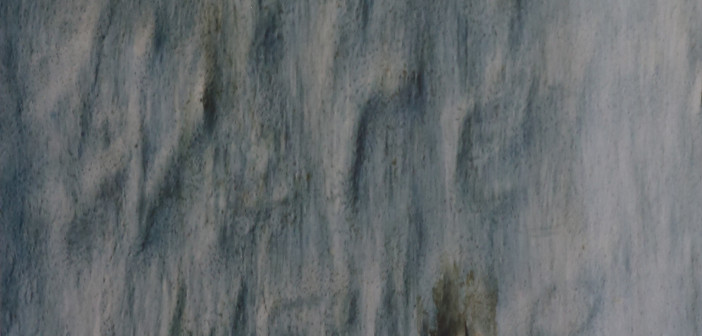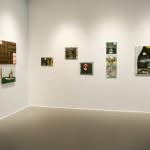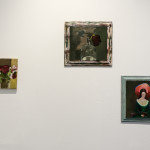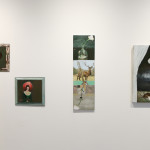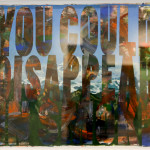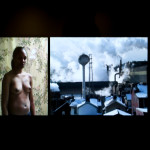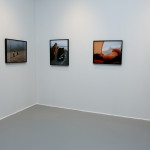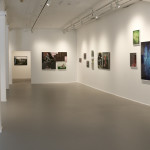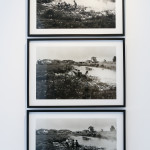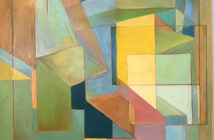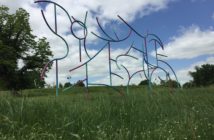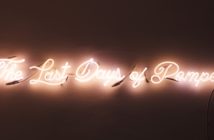"There's nothing simple about getting back to nature.” Steve Locke, who curated Arcadia: Thoughts on the Contemporary Pastoral at the Mills Gallery, Boston Center for the Arts, began his gallery talk with this cautionary statement, and a gift for each of us. He made postcards of the painting that inspired the exhibition, Et in Arcadia Ego, by Nicolas Poussin. In it, three shepherds come across a tomb in an ancient, pastoral setting. A shepherd kneels to trace his shadow on the tomb's wall with rapt amazement. An attractive, classically robed woman, embodying Arcadia, looks on. Locke explained the painting’s significance, saying that it represents the dawn of painting, as the man transposes his own form onto the world, creating both art and a reminder of death. The threat of death remains near us throughout the exhibition.

Eirik Johnson, We Were Here, 2015, Digital prints, 20” x 16” Photo by Melissa Blackall Photography at Mills Gallery, Boston Center for the Arts, Arcadia: Thoughts on the Contemporary Pastoral, July 10-September 20, 2015.
During his gallery talk, Locke said that he does not draw a line between humans and nature, as he considers humans and their actions as much a part of nature as wild animals or natural disasters.[1] "That nature is contained is a myth," he said. Yet history provides us with a litany of examples of people actively trying to separate civilization from nature in the form of fences, curbs, and concrete walls. The landscapes in this exhibition are as much about the limits and the boundaries humanity has created to define the world as the actual soil, trees, and bodies of water. The artwork shown here embraces the built, the imagined, the visited, and the inhabited.
A few pieces near the entry place an emphasis on scale. Our experience of the landscape is often removed from reality and seen on a smaller scale, such as digital interfaces on tiny screens, and forests and hillsides viewed from moving car interiors. A sculpture by Leah Gadd, I’ll Stop the World and Melt With You, stands in a large window and is visible from the square that borders Tremont Street. The snow-covered earth is made of foam carved to a height made even more absurdly vertiginous by the tiny model tree placed at the top. Although the sculpture references something monumental, it is lightweight and just 60 inches high. The little tree is green, contrasting with the all-white chunk of “earth” it “grows” from. Although it is not realistic, this model of an impressive, icy peak speaks to us nonetheless, and to our familiarity with images of remote places that we have likely never seen.

Leah Gadd, I’ll Stop the World and Melt with You, detail, 2015, Foam, model tree, gloss medium, 60” x 11”
Photo by Melissa Blackall Photography
Frank Meuschke’s dainty oil paintings of Prospect Park seem to inhabit the same tiny world as Gadd’s sculpture; the small figures present in Meuschke’s work could fit under Gadd’s tree. They hang in a small room adjacent to the gallery’s entryway, and as a group they seem remote from the rest of the show, providing a journey within a journey for gallery visitors in an exhibition about how we consider spaces. The paintings are gem-like in their accuracy, depicting casual scenes from a jogger's gaze. The point of view of the works is not specifically threatening, although it reminds us of the near-constant surveillance we experience in public spaces, whether from fellow citizens or from digital devices.
When we consider human actions as much a part of nature as a tree falling or a lion hunting, as Locke suggested during his gallery talk, urban environments emerge as valid subjects for landscape paintings. Locke’s grouping of artwork seems to ask; what does a utopian landscape look like? The works collectively suggest that a meaningful representation of contemporary landscape is no longer about escape, but rather about recognizing the changes in our world.
LaToya Ruby Frazier’s Self Portrait (United States Steel) focuses on the insidious, long-term damage wrought by pollution. In the first frame of the two-frame digital video, the artist stands before a sheer curtain, gazing directly at the camera with her torso exposed as she tries (with effort) to fill her lungs.

LaToya Frazier, Self Portrait (United States Steel), 2010, Digital video color, sound, 3’28 Edition of 7
In the right frame, plumes billow from smokestacks of United States Steel Corporation in Braddock, PA, the artist’s hometown. Frazier has lupus, one of the many diseases that plague Braddock’s residents. Self-Portrait provides the viewer with a personal example of the damage that the plant (one of the longest-running factories in the country) has caused Braddock’s population. The videos enable us to simultaneously see the rise and fall of her chest and the continuous output of smoke from the factory. The sheet behind her is printed with floral patterns that reference real foliage but is decidedly not a source of oxygen. We could read multiple meanings into Frazier’s title, Self Portrait (United States Steel). It is descriptive, with words that name the subjects in the two frames. Alternatively, the parenthetical use of the factory’s name beside her portrait alludes to how United States Steel is a part of her- the actions of the factory have been absorbed into her body.
You could disappear in smoke by Joe Wardwell announces its title in large block letters across the canvas. Wardwell’s work is an intense hodge-podge of textures made up of two landscapes painted on top of one another. Bold, sans-serif letters form phrases that are not immediately legible. Numerous colors refract and hum, their shapes oscillating between the two layers. The lack of clarity, both of form and phrase, come across as vaguely threatening, at odds with the lush palette. Wardell’s chosen phrases, overlaid on a landscape, echo the style of vintage 1930's postcards, where large letters (often spelling the name of a tourist destination) are set at a jaunty angle over the landscape.
Across the gallery, spindly letters spell out, “We Were Here” in a photograph of words the artist Erik Johnson found carved into trees Another photograph shows “The Smith’s,” carved into a trunk, the words likely referring to the English rock band formed in the early 1980s. Johnson crops in close to the trees and filters the images with cool colors, making the surfaces reminiscent of cave walls. Looking at his photographs, one has the feeling that ancient conversations are being unearthed; the urgency or impulse of the person who wrote these notes is absent, but the messages remain. Many of these words have healed over, and we can see that the trees have learned to live with their scars.
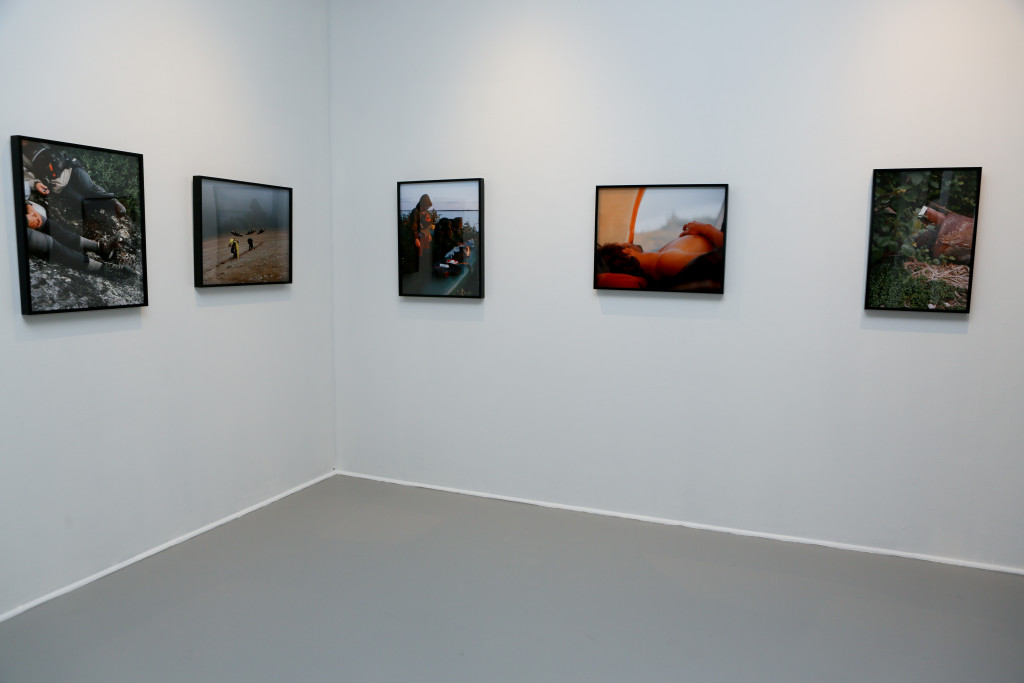
Installation view, Ryan Arthurs, Untitled, Labrador, 2012, Digital prints, 16” x 20” Photo by Melissa Blackall Photography at Mills Gallery, Boston Center for the Arts, Arcadia: Thoughts on the Contemporary Pastoral, July 10-September 20, 2015.
Locke selected artists for Arcadia who respond to timely issues, including climate change, pervasive surveillance, and our attachment to technology. The fragility of the human condition is captured in the subtle photographs of Ryan Arthurs. He hiked with a small group to Labrador, a remote region on the northern border of Canada. His photographs do not crop his and his companions’ presence from the landscape, and the images that include people are among the most memorable. One shows a young, shirtless man lying in a tent, gazing outwards. The orange door of the tent frames the landscape, which is blurred into pleasing pastel colors with no specifics such as trees or the horizon. We focus, rather, on the specific experience of Arthurs and his companions. Other images in Arthurs’ series show the involved process of camping in a remote area. In one scene, two figures survey the cooking supplies they’ve laid out on their upturned canoe through the mosquito nets covering their faces. We can surmise that their dinner will be as time-consuming to prepare as their clothing is elaborate. They focus on their goods rather than on the land around them; it is what they carried in that will help them survive, and Arthurs’ framing enhances our sense that their supplies are essential in this remote location.
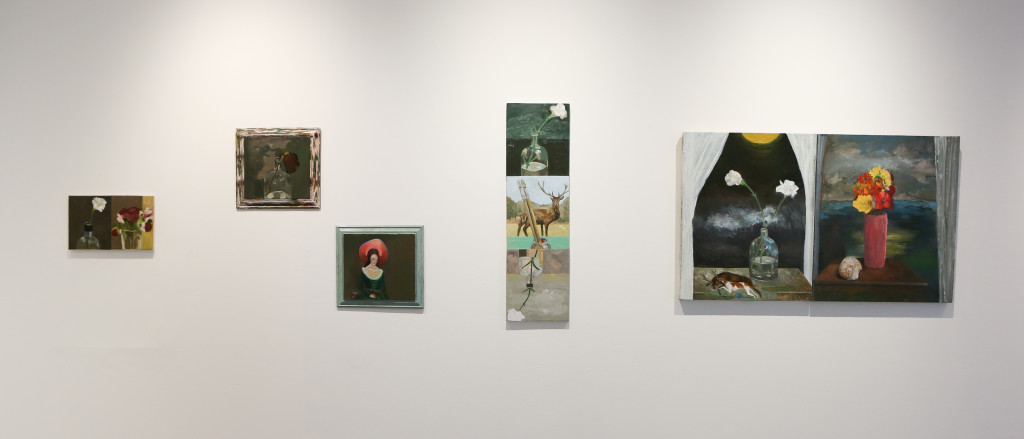
Matthew Noonan, This and That (for JAN), 2015, Oil on canvas, 10” x 16” Play (For Mae), 2015, Oil on canvas, 30” x 50” Falling (For Ellen), 2015, Oil on wood, 39” x 11” In Relation to What, 2015, Oil on wood, 27” x 35”
A group of oil paintings by Matthew Noonan steal the show with their mysterious yet familiar subject matter and their bold brushwork. Art historical references appear throughout his work: dark, bowed blooms of dead flowers, angelic females, and a Picasso-like bull’s head. His paintings blur the boundaries between interior and exterior spaces and integrate characteristics of both still life and landscape. The painting In Relation to What suggests multiple meanings. We can’t tell whether a small dog truly chases a deer on a windowsill, or if the figures are a part of someone’s reverie. The painting beside it, Falling (for Ellen) stacks three images in a vertical arrangement. In the top scene, a cut flower rests in a clear glass vase. In the center scene, a deer in a field faces a jar with two paintbrushes. The brushes could easily be read as arrows threatening the life of the deer. In the lowest scene, a similar cut flower rests in a clear glass vase. Taken together, the flowers and the brushes create a loose S-curve that join the three separate scenes to form a subtle pattern directing the viewer’s gaze across the painting. The backgrounds shift from atmospheric to flat, interrupting the illusion that they describe a specific place or thing. Noonan’s work reminds us not to take for granted the distinct styles of still life, landscape, and portraiture, as there will always be ways to push those boundaries, and innovative ways for them to merge. His intimate awareness of art history echoes the way Locke, also an accomplished painter, curates a contemporary journey through the landscape.
Locke’s choice and placement of work positions this show very much in the present. The works relate conceptually more so than stylistically, as the art covers a wide range of moods and media. Lovely, subtle, black and white photographs by Anri Sala and large, bold, mandala-like monoprints by Marie Lorenz stand on either end of a wide spectrum of approaches. Frazier’s video speaks to the burdens of pollution and Meuschke’s paintings remind us that most outdoor experiences are constrained by planned environments and the proximity of other people, and the inclusion of these artists adds to the over-arching attitude of the exhibition; that even if things were better in the past, we are inextricably bound to the landscape we live in now. Despite the artists’ contrasting approaches to crafting meaning, the works in the show are not escapist; from the humor and irony of Gadd, to the sincere tone of Johnson, all of the works in Arcadia urge us to embrace and interrogate reality rather than seek escape or utopia.
Locke asked that we mail the postcard of Et in Arcadia Ego that he’d given us to someone, prompting me to consider whether I could possibly summarize the card’s origins to its future recipient on such a small space. Postcards are usually light-hearted, and this one is freighted with a reminder of death and the beauty that allows us to coexist with the knowledge of our own mortality. The contemporary equivalent of an Arcadian landscape may not be a peaceful, lush Garden of Eden, but rather a landscape that somehow enables us to make peace with a complex and imperfect world. This exhibition suggests an epiphany for contemporary viewers, beyond that of the shepherd. The sum of our actions and our attitudes is reflected in the landscapes that surround us.
[1] Steve Locke, Gallery Talk, “A Walk Through Arcadia,” Mills Gallery, Thursday, July 16, 2015, 6:30 – 7:30 pm.
- Installation view, Matthew Noonan, L-R: Adrift (For Ema), 2015, Oil on canvas, 44” x 66” This and That (for JAN), 2015, Oil on canvas, 10” x 16” Play (For Mae), 2015, Oil on canvas, 30” x 50” Falling (For Ellen), 2015, Oil on wood, 39” x 11” In Relation to What, 2015, Oil on wood, 27” x 35” This and That (for JAN), 2015, Oil on canvas, 10” x 16” Photo by Melissa Blackall Photography at Mills Gallery, Boston Center for the Arts, Arcadia: Thoughts on the Contemporary Pastoral, July 10-September 20, 2015.
- Matthew Noonan, This and That (for JAN), 2015, Oil on canvas, 10” x 16” Play (For Mae), 2015, Oil on canvas, 30” x 50” Falling (For Ellen), 2015, Oil on wood, 39” x 11” Photo by Melissa Blackall Photography at Mills Gallery, Boston Center for the Arts, Arcadia: Thoughts on the Contemporary Pastoral, July 10-September 20, 2015.
- Matthew Noonan, This and That (for JAN), 2015, Oil on canvas, 10” x 16” Play (For Mae), 2015, Oil on canvas, 30” x 50” Falling (For Ellen), 2015, Oil on wood, 39” x 11” In Relation to What, 2015, Oil on wood, 27” x 35” Photo by Melissa Blackall Photography at Mills Gallery, Boston Center for the Arts, Arcadia: Thoughts on the Contemporary Pastoral, July 10-September 20, 2015.
- Eirik Johnson, We Were Here, 2015, Digital prints, 20” x 16” Photo by Melissa Blackall Photography at Mills Gallery, Boston Center for the Arts, Arcadia: Thoughts on the Contemporary Pastoral, July 10-September 20, 2015.
- Joe Wardwell, You Could Disappear, 2015, Oil and vinyl on paper, 22” x 26” Photo by Melissa Blackall Photography at Mills Gallery, Boston Center for the Arts, Arcadia: Thoughts on the Contemporary Pastoral, July 10-September 20, 2015.
- LaToya Frazier, Self Portrait (United States Steel), 2010, Digital video color, sound, 3’28 Edition of 7 Photo by Melissa Blackall Photography at Mills Gallery, Boston Center for the Arts, Arcadia: Thoughts on the Contemporary Pastoral, July 10-September 20, 2015.
- Installation view, Ryan Arthurs, Untitled, Labrador, 2012, Digital prints, 16” x 20” Photo by Melissa Blackall Photography at Mills Gallery, Boston Center for the Arts, Arcadia: Thoughts on the Contemporary Pastoral, July 10-September 20, 2015.
- Frank Meuschke, Prospect Park, 2012, Oil on muslin mounted on panel, 12” x 16” Photo by Melissa Blackall Photography
- Leah Gadd, I’ll Stop the World and Melt with You, detail, 2015, Foam, model tree, gloss medium, 60” x 11” Photo by Melissa Blackall Photography
- Leah Gadd, I’ll Stop the World and Melt with You, 2015, Foam, model tree, gloss medium, 60” x 11” Photo by Melissa Blackall Photography at Mills Gallery, Boston Center for the Arts, Arcadia: Thoughts on the Contemporary Pastoral, July 10-September 20, 2015.
- Installation view, Arcadia: Thoughts on the Contemporary Pastoral Photo by Melissa Blackall Photography at Mills Gallery, Boston Center for the Arts, Arcadia: Thoughts on the Contemporary Pastoral, July 10-September 20, 2015.
- Anri Sala, Two, Three, Four (Two, Three, Four), 2001, Black and white gelatin silver print, 24” x 30” Photo by Melissa Blackall Photography at Mills Gallery, Boston Center for the Arts, Arcadia: Thoughts on the Contemporary Pastoral, July 10-September 20, 2015.
- Marie Lorenz, Fence, Bottle, Basket, Glass, 2014, Ink on KozoShi, 96” x 96” Photo by Melissa Blackall Photography at Mills Gallery, Boston Center for the Arts, Arcadia: Thoughts on the Contemporary Pastoral, July 10-September 20, 2015.

